Are you here because you want to know how to stop shoes from rubbing the back of your ankle when you’re walking? I’ve experienced it myself — having to stop, adjust, and come up with a different way to walk in fear of my shoes causing blisters on the back of my heel. It’s uncomfortable to be honest, but I managed to overcome it with a few simple steps below.
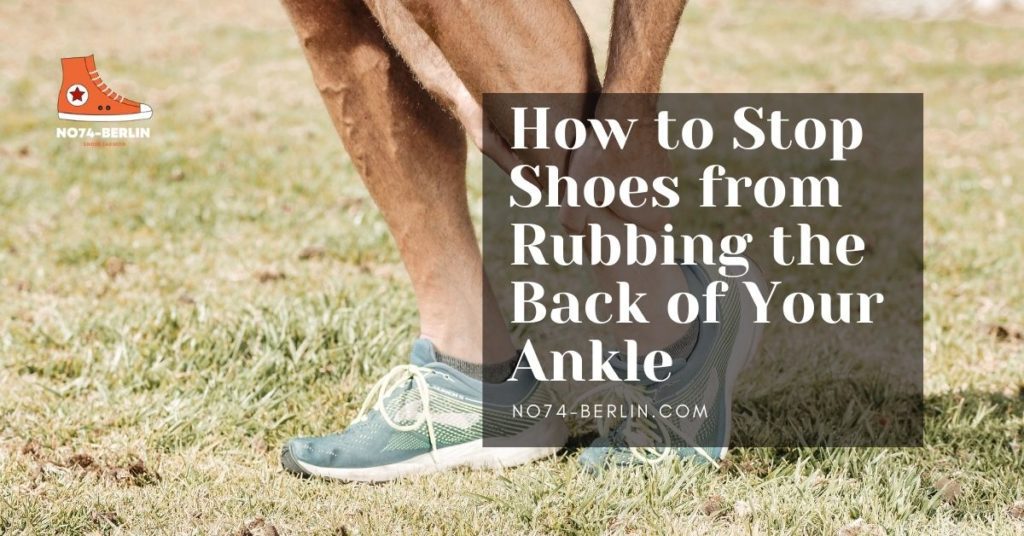
When you’re doing your activities, the last thing you want is a pair of shoes that makes life difficult. But before we share some tips on how to stop shoes from rubbing the back of your ankle, you might want to put these items first in your checklist.
What you’ll need:
- The right size shoe
- Shoe Softener
- Shoe Conditioner
- Damp Newspaper
- Soap
- Insole: to adjust the shoe’s fit
- Heel Grips
- Stretch out the shoes
- Using Hairdryer (An all around device)
- A Shoe Tree
- Shoe Stretcher
- Thick Socks
- Moleskin pad
- Anti-friction Sticks
- Band-aids
- Anti-perspirant
- Professional Aid
Why do Shoes Rub the Back of Your Ankle?
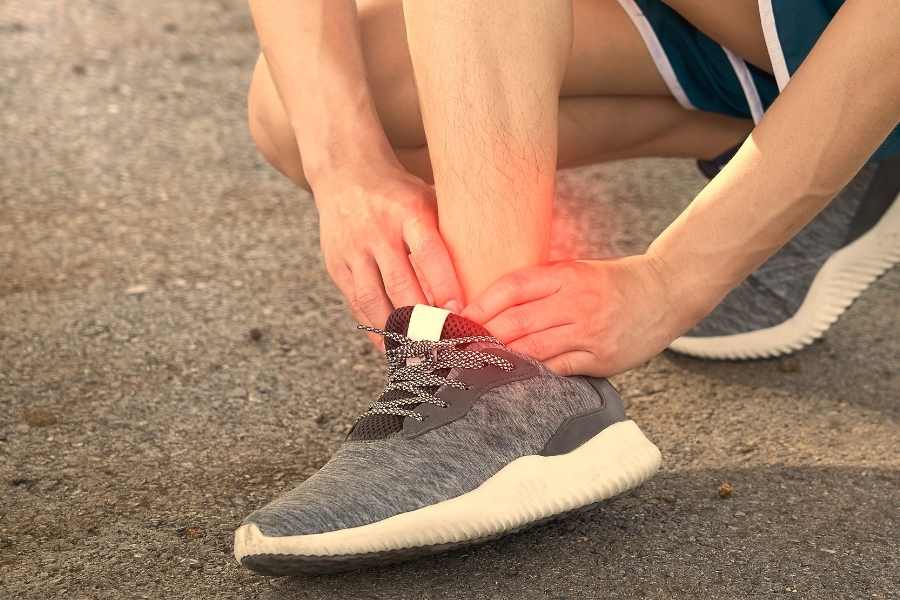
Shoes rub the back of your ankle if your shoe has a stiff back. It’s because the majority of its support comes from a rigid structure that may not be flexible enough to allow for maximum movement. This can lead to rubbing and other discomforts as you walk. The worst is causing painful blisters at the back of your ankle.
Few reasons might be due to;
- Your shoes are new and need breaking in to conform to your foot.
- The shoe’s design does not match your foot.
- Low-quality rubber soles don’t provide enough cushions, which forces your foot to bear too much pressure.
- Also, tight laces squeeze your foot and leave a mark on the soft tissue behind your heel bone.
Yes, it’s not always your fault that you chose the wrong size and style. It could even be a factory defect or a manufacturer’s glitch too.
How to Stop Shoes from Rubbing the Back of Your Ankle
We hate foot blisters as much as you do — that’s why we’ve put together a guide on how to stop your shoes from rubbing the back of your ankle.
Pick the right size of shoes
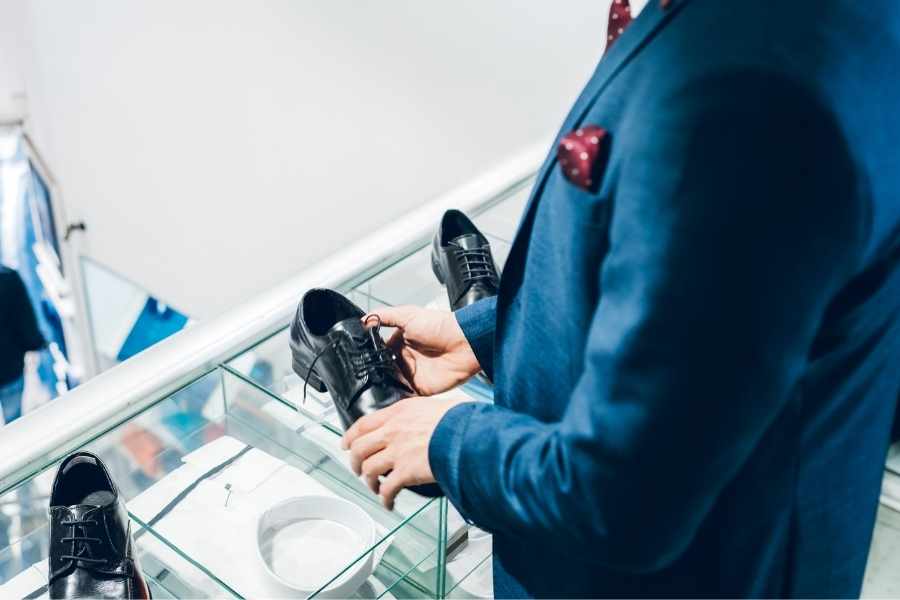
When you pick the right shoe size you don’t have to walk uncomfortably. Your shoes won’t put extra pressure on your ankles too, causing pain and irritation to arise. Remember that without a snug fit, excess movement will cause rubbing and friction that can lead to blisters and cuts. You don’t want that.
Shoe sizes are inconsistent and often vary across different brands. Every foot is unique and walking in the shoes first, before swiping that card can ensure that it’s a comfortable fit for you.
But if you bought the wrong size of shoes, below are my tips on how to stop shoes from rubbing the back of your ankle.
Use Shoe Softeners
Some shoes, especially new ones come with a stiff back that rubs the back of your ankles. You might need to break it in, so it will eventually soften and fit nicely around your ankle.
It’s very common for shoes to make your feet tender at first, especially new ones but don’t give up on them yet. They will soften with use over time. But you can also try a faster route with the items listed below.
Either methods below should help you on how to stop shoes from rubbing the back of your ankle.
Shoe Conditioner
Apply a Shoe Conditioner to the part of the shoe that is most scratchy. You can leave it overnight. But, mind you, the part where you applied the conditioner might change color. This method is most suitable for leather and suede shoes.
Damp Newspaper
Roll up thin sheets of damp newspaper until they’re into small balls. Stuff them into your shoes overnight. By saturating the newspaper in water and putting it into the shoe, you’ll force the leather to absorb more moisture quickly.
This might cause cracking or stiffness but to prevent this you can apply a leather conditioner periodically to the shoes. A leather conditioner will keep the leather soft and supple.
Soap
Rubbing soap into the inside of your shoes is another quick and effective way to make your shoes more comfortable. This method will soften the leather and make it more pliable, which in turn lets you free from blisters caused by stiff new shoes.
So those are my tips on how to stop shoes from rubbing the back of your ankle using shoe softeners. If you’re looking for another ways, keep reading!
Insole to adjust the shoe’s fit
Shoes with too much room in the toe box can cause friction by letting your foot move around too much. Excess movement causes friction and can, over time, deteriorate your shoes. Quality insoles will help your shoes stop rubbing the back of your ankle.
Use Heel Grips
Heel grips can help you if you’re still looking for a way on how to stop shoes from rubbing the back of your ankle.
While heel grips don’t necessarily hold your feet in place, they do cushion your heels to prevent chafing. The gel-made material also cushions the bottom of your foot, preventing it from slipping in shoes. It lessens the friction as well to prevent nasty blisters from rubbings.
Stretch Out Your Shoes
Sometimes you have to take your shoes off when they’re new. Not because they’re uncomfortable or unfashionable. But because they’re too tight. If you want to make them last longer, you’ll need to stretch out the back so that the shoe isn’t rubbing against the back of your ankle.
Below are items that can help you solve your problem on how to stop shoes from rubbing the back of your ankle.
Use a Hairdryer
An all-around device not only meant for drying your hair but for shrinking and molding your shoes too. To make new shoes feel more comfortable and preventing blisters, follow the steps below.
- Place your shoes in a paper bag.
- Run the hairdryer on new shoes for 20 minutes.
- Afterward, wear them with thick socks while walking around.
- As the shoes cool down, they should mold to your feet, making them more comfortable to wear.
If they don’t fit well after this process, you can repeat it until they do.
Reconsider using a hairdryer on plastics and synthetics because it may cause damage. Even on leather and fabric, extreme heat or prolonged exposure to heat may warp your shoes.
Use a Shoe Tree
Also known as wood inserts, shoe trees are not just made from wood. It is also a mixture of different materials that give the shoe trees their unique texture, shape, and fragrance.
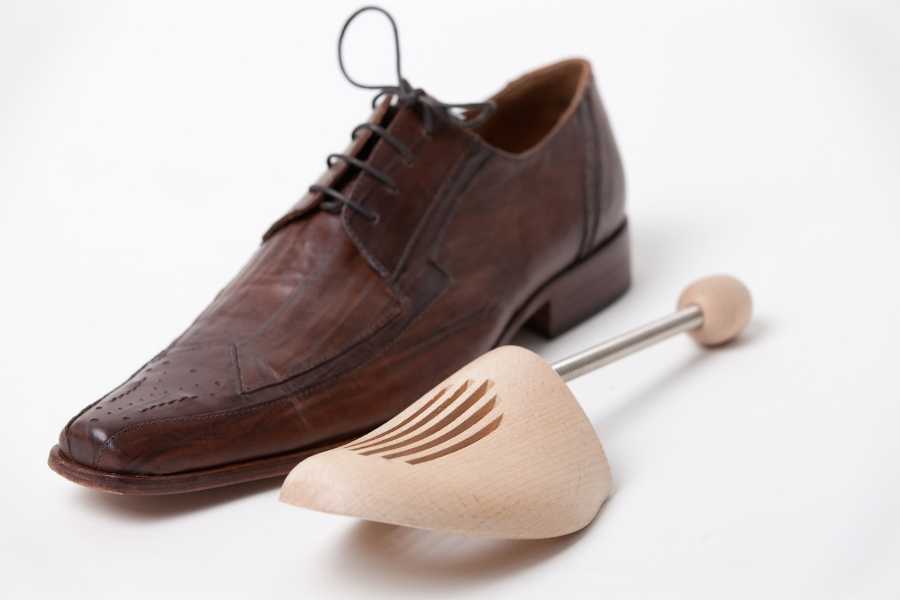
Follow simple steps below:
- You need to take off the shoe and place the tree inside;
- Leave it there overnight so that the wood can reshape your shoe to a wider fit.
- Keep leaving your shoes on the tree for several consecutive days until you notice a stretch in width and length.
You might also see some stretching at the front and back of your shoes. This will give you a perfectly fitted shoe over time that will help avoid the rubbing situation at the back of your ankle.
Shoe Stretcher
A shoe stretcher is a device used to stretch out the length of your shoes or boots. Found in many pairs of shoes, it looks like a stick with a knob on one end and an open hole for your fingers on the other. To use and avoid rubbings, check steps as follows;
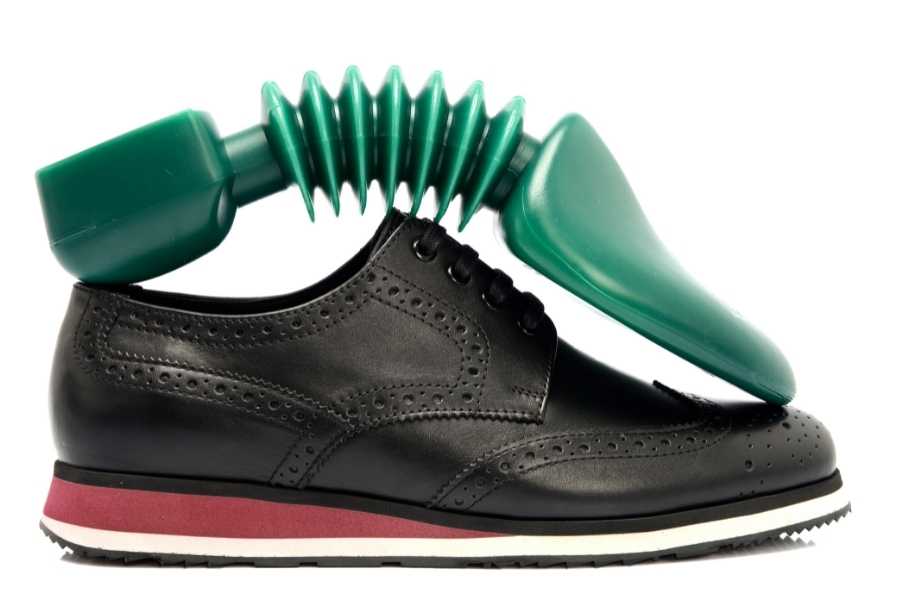
- Hold the shoe stretcher by its knob and adjust the handle so that it matches the width of your shoe and rests comfortably in your hand.
- With your other hand, hold the shoe from its heel, and then insert the stretcher into the shoe, pushing it until you feel resistance.
- Use your wrist to turn the knob; this expands the stretcher and stretches out your shoe.
Repeat these steps until you get your desired fit. Take note of leaving it for about eight hours before getting your shoes out of the stretcher.
Added Tip:
Although it will take time, you may be able to stretch your shoes a little by walking around in them at home for short periods. This method can be slower but will potentially save you money because you won’t need to replace them as quickly.
Wear Thick Socks

One way to avoid blisters and stop your shoes from rubbing the back of your ankle is to wear thick or double socks.
The thickness of your socks protects your feet and stabilizes your shoes. This is perfect for when your shoes start rubbing halfway through a walk or a full workday.
Use Moleskin Pad
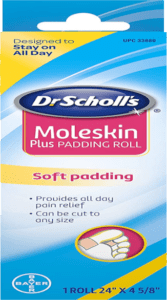
Moleskin is a cotton fabric that you can stick to your shoe or your skin. It’s an excellent way to avoid blisters and rubbed spots in the long run.
- Start by cutting thick enough moleskin to cover the entire area of your heel that is bothering you.
- Apply the moleskin to the affected area using a pen as an outline.
- Remove the backing and carefully apply it to your skin.
- You can also stick it directly into your skin.
Added Tip:
Make sure you cover more area than the mole itself. This will ensure that the adhesive will be more durable and less likely to come off on your clothes. When the mole is fully cured, you can also slip on a thin pair of socks over it to help keep it in place for even longer.
You could use Dr. Scholl’s Moleskin Plus Padding Roll to avoid that dreadful friction but the moleskin won’t stick to a dirty surface. So, always clean your heel first.
Use Anti-friction Balm/Sticks
The balm provides a cushioning effect to reduce friction, improving the comfort of your shoes. However, if you’re wearing tight-fitting shoes, the balm may get wiped out. In these cases, apply the balm again to restore its lubricating effect.
Use Band-aid
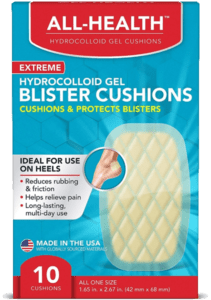
A Band-aid can also be prevention than an aid for repercussion. You can put a band-aid at the back of your ankle to avoid contact with your shoes thus prevents blisters.
But more often we used Band-aids if blisters have already formed on our ankles, it’s still essential to protect them. Putting Band-aid will prevent infections and stop further damage from occurring.
You can try All Health Blister Cushion Band-aids. These cushioned and waterproof heel bandages prevent blisters and speed up healing times.
Use Antiperspirant
There’s a simple trick to avoiding blisters on your feet. You see, like your armpits, your feet tend to sweat. The moisture from the sweat can cause blisters when rubbing against friction—especially when wearing new shoes. Applying your favorite antiperspirant before you wear your new shoes can help keep your feet dry and blister-free.
Save your foot’s skin, and choose a powdery antiperspirant over a wet one like gel types. The powders are less irritating.
Professional Aid
Finally, if all else fails seek shoe experts’ help.
If your shoes are causing blisters, take them to a professional shoe repairman for sizing, the addition of rubbers, and maybe even a new insole.
Properly sized shoes are the key to preventing the swollen back of your ankles. If you feel like your shoes might be causing you some problems; go see a shoe repairman for a permanent and faster fix.
Be prepared to disburse a hefty sum for this option though. But it will be worth it anyway. If you can dodge extra expenses for your medical bills once you’ll get an infection.
Extra Tip: Take care of your feet
The most important part of a shoe is the size and fit – not only for aesthetics but for the general health of your feet. Paired with an excellent pair of shoes, there are several simple things you can do to keep your feet in tip-top condition:
- Wash and dry your feet daily.
- Moisturize them regularly to help keep your skin soft and supple.
- Use a pumice stone to remove rough dead skin but do it gently so you don’t damage your skin.
- Trim your toenails when they get too long. Being too long can affect your entire foot and cause problems with your ankles.
Conclusion
Blisters aren’t just bad for your feet — they can also make working a job that requires you to be on your feet all day next to impossible. Fortunately, there are methods you can take to prevent blisters from occurring when you’re on the job.
You can follow our tips and tricks to prevent blisters and soreness in the back of your ankles. You’ll surely be walking confidently in your new shoe worry-free from now on.
We hope you enjoyed our guide on how to stop shoes from rubbing the back of your ankle. What do you think about this problem? Do you have any experience with it? Leave us a comment below! Don’t forget to share as well.
